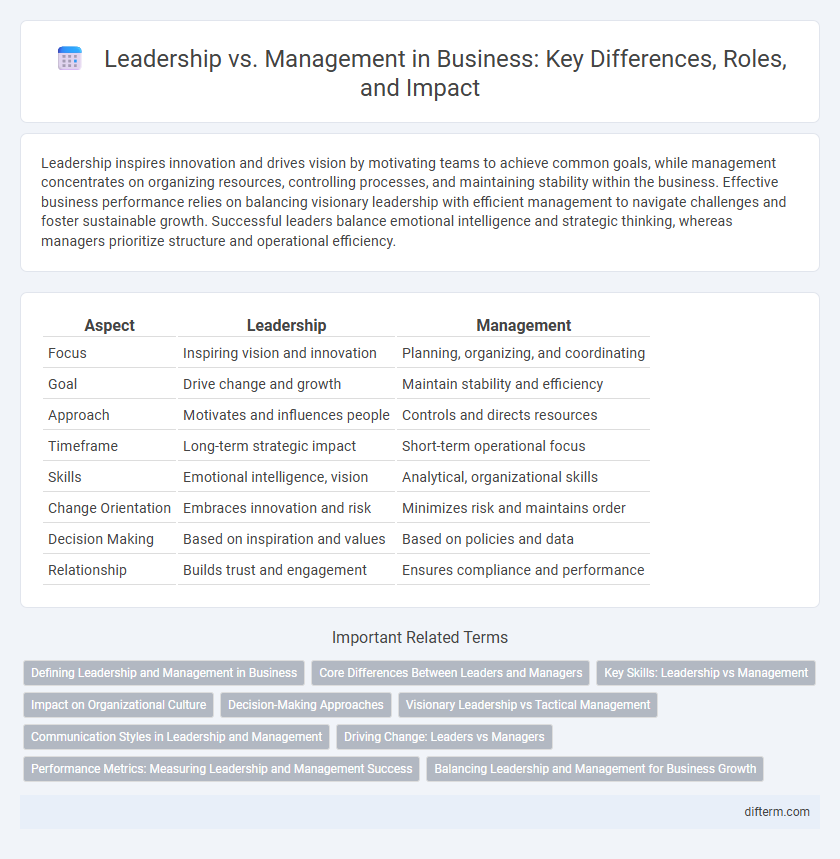Leadership inspires innovation and drives vision by motivating teams to achieve common goals, while management concentrates on organizing resources, controlling processes, and maintaining stability within the business. Effective business performance relies on balancing visionary leadership with efficient management to navigate challenges and foster sustainable growth. Successful leaders balance emotional intelligence and strategic thinking, whereas managers prioritize structure and operational efficiency.
Table of Comparison
| Aspect | Leadership | Management |
|---|---|---|
| Focus | Inspiring vision and innovation | Planning, organizing, and coordinating |
| Goal | Drive change and growth | Maintain stability and efficiency |
| Approach | Motivates and influences people | Controls and directs resources |
| Timeframe | Long-term strategic impact | Short-term operational focus |
| Skills | Emotional intelligence, vision | Analytical, organizational skills |
| Change Orientation | Embraces innovation and risk | Minimizes risk and maintains order |
| Decision Making | Based on inspiration and values | Based on policies and data |
| Relationship | Builds trust and engagement | Ensures compliance and performance |
Defining Leadership and Management in Business
Leadership in business involves inspiring and guiding teams toward a shared vision, emphasizing motivation, innovation, and change management. Management focuses on planning, organizing, and coordinating resources to achieve specific organizational goals efficiently and consistently. Both leadership and management are essential for business success, balancing visionary direction with operational execution.
Core Differences Between Leaders and Managers
Leaders inspire vision, drive innovation, and foster motivation, focusing on long-term goals and change. Managers prioritize planning, organizing, and controlling resources to achieve short-term objectives and maintain stability. The core difference lies in leaders influencing people and managers directing processes for operational efficiency.
Key Skills: Leadership vs Management
Effective leadership centers on visionary thinking, emotional intelligence, and the ability to inspire and motivate teams toward shared goals. In contrast, management emphasizes organizational skills, process optimization, and monitoring performance to achieve operational efficiency. Mastery of communication is crucial in both roles, enabling leaders to influence change and managers to enforce structure.
Impact on Organizational Culture
Leadership shapes organizational culture by inspiring innovation, fostering trust, and promoting adaptability, which drives long-term growth and employee engagement. Management enforces policies and processes that maintain operational consistency and efficiency, ensuring day-to-day stability within the corporate environment. Together, effective leadership and management cultivate a dynamic culture that balances vision with execution, enhancing overall organizational performance.
Decision-Making Approaches
Leadership emphasizes visionary decision-making that inspires innovation and long-term growth, while management concentrates on structured decision processes aimed at efficiency and operational consistency. Leaders prioritize adaptive strategies to navigate uncertainty, whereas managers rely on established protocols and data-driven analysis to maintain control. Understanding this distinction enhances organizational effectiveness by aligning decision-making approaches with business goals.
Visionary Leadership vs Tactical Management
Visionary leadership drives long-term growth by inspiring innovation and setting strategic direction, while tactical management ensures operational efficiency through detailed planning and resource allocation. Effective business success requires integrating visionary leadership's creativity with tactical management's execution precision. Organizations that balance forward-thinking vision with disciplined management achieve sustained competitive advantage.
Communication Styles in Leadership and Management
Leadership communication emphasizes vision-sharing, inspiration, and active listening to motivate teams and foster innovation, while management communication centers on clarity, instruction, and feedback to ensure task completion and operational efficiency. Leaders use storytelling and emotional intelligence to connect with employees, whereas managers rely on structured updates and performance metrics to maintain control and monitor progress. Effective organizational success depends on balancing these communication styles to align strategic goals with daily execution.
Driving Change: Leaders vs Managers
Leaders drive change by inspiring vision and fostering innovation, encouraging teams to embrace new opportunities and adapt proactively. Managers focus on implementing structured processes, ensuring stability and efficiency while guiding teams through planned transitions. The dynamic between leadership and management is crucial for balancing creative transformation with operational control in business growth.
Performance Metrics: Measuring Leadership and Management Success
Leadership success is often evaluated through qualitative performance metrics such as employee engagement, innovation rates, and team morale, reflecting the ability to inspire and influence. Management success relies heavily on quantitative metrics like project completion rates, budget adherence, and operational efficiency, highlighting effective planning and resource allocation. Combining these metrics provides a comprehensive view of organizational performance, balancing visionary leadership with practical management.
Balancing Leadership and Management for Business Growth
Effective business growth hinges on balancing leadership and management by integrating visionary guidance with operational efficiency. Leaders inspire innovation and motivate teams, while managers ensure structured processes and resource allocation are executed precisely. Harmonizing these roles fosters a dynamic environment where strategic goals align with practical implementation, driving sustainable success.
Leadership vs Management Infographic

 difterm.com
difterm.com